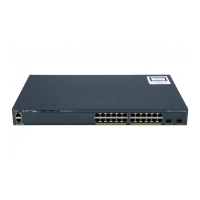38-21
Catalyst 2960 and 2960-S Switches Software Configuration Guide, Release 15.0(1)SE
OL-26520-01
Chapter 38 Configuring EtherChannels and Link-State Tracking
Displaying EtherChannel, PAgP, and LACP Status
Displaying EtherChannel, PAgP, and LACP Status
You can clear PAgP channel-group information and traffic counters by using the clear pagp
{channel-group-number counters | counters} privileged EXEC command.
You can clear LACP channel-group information and traffic counters by using the clear lacp
{channel-group-number counters | counters} privileged EXEC command.
For detailed information about the fields in the displays, see the command reference for this release.
Understanding Link-State Tracking
Note To use Link-state tracking, the switch must be running the LAN Base image.
Link-state tracking, also known as trunk failover, is a feature that binds the link state of multiple
interfaces. For example, link-state tracking provides redundancy in the network when used with server
NIC adapter teaming. When the server network adapters are configured in a primary or secondary
relationship known as teaming, if the link is lost on the primary interface, connectivity is transparently
changed to the secondary interface.
Note An interface can be an aggregation of ports (an EtherChannel), or a single physical port in access or trunk
mode.
Figure 38-6 on page 38-23 shows a network configured with link-state tracking. To enable link-state
tracking, create a link-state group, and specify the interfaces that are assigned to the link-state group. In
a link-state group, these interfaces are bundled together. The downstream interfaces are bound to the
upstream interfaces. Interfaces connected to servers are referred to as downstream interfaces, and
interfaces connected to distribution switches and network devices are referred to as upstream interfaces.
The configuration in Figure 38-6 ensures that the network traffic flow is balanced as follows:
• For links to switches and other network devices
–
Server 1 and server 2 use switch A for primary links and switch B for secondary links.
–
Server 3 and server 4 use switch B for primary links and switch A for secondary links.
Table 38-4 Commands for Displaying EtherChannel, PAgP, and LACP Status
Command Description
show etherchannel [channel-group-number {detail |
port | port-channel | protocol | summary}] {detail |
load-balance | port | port-channel | protocol |
summary}
Displays EtherChannel information in a brief, detailed, and
one-line summary form. Also displays the load-balance or
frame-distribution scheme, port, port-channel, and protocol
information.
show pagp [channel-group-number] {counters |
internal | neighbor}
Displays PAgP information such as traffic information, the
internal PAgP configuration, and neighbor information.
show pagp [channel-group-number] dual-active Displays the dual-active detection status.
show lacp [channel-group-number] {counters |
internal | neighbor}
Displays LACP information such as traffic information, the
internal LACP configuration, and neighbor information.

